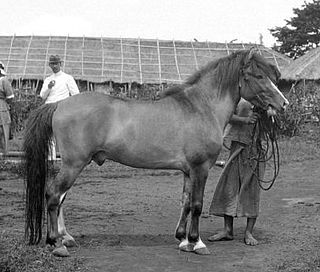Related Research Articles
Horse breeding is reproduction in horses, and particularly the human-directed process of selective breeding of animals, particularly purebred horses of a given breed. Planned matings can be used to produce specifically desired characteristics in domesticated horses. Furthermore, modern breeding management and technologies can increase the rate of conception, a healthy pregnancy, and successful foaling.

Warmbloods are a group of middle-weight horse types and breeds primarily originating in Europe and registered with organizations that are characterized by open studbook policy, studbook selection, and the aim of breeding for equestrian sport.

The Icelandic horse, or Icelandic, is a breed of horse developed in Iceland. Although the horses are smaller compared to other breeds, most registries for the Icelandic refer to it as a horse. The breed is long-lived and hardy, owing to the ruggedness of its home country. In their native Iceland they have few afflictions or diseases, thus national laws are in place preventing foreign-born horses from being imported into the country, while exported animals are not permitted to return. In addition to the gaits of walk, trot, and canter/gallop, typical of other horse breeds, many Icelandic horses can also do the tölt and the flying pace. The only breed of horse in Iceland, the Icelandic is also popular internationally, and sizable populations exist in Europe and North America. The breed is still used for traditional sheepherding work in its native country, as well as for leisure, showing, and racing.
A banner is an administrative division of the Inner Mongolia Autonomous Region in China, equivalent to a county-level administrative division.
Xilinhot is a county-level city which serves as the seat of government for the Xilingol League in Inner Mongolia, China. In 2010, it has a jurisdiction area of 14,785 km2 (5,709 sq mi) and a population of 245,886; 149,000 people live in the Xilinhot urban area.

The Mongolian horse is the native horse breed of Mongolia. The breed is purported to be largely unchanged since the time of Genghis Khan. Nomads living in the traditional Mongol fashion still hold more than 3 million animals, which outnumber the country's human population. In Mongolia, the horses live outdoors all year, dealing with temperatures from 30 °C (86 °F) in summer down to −40 °C (−40 °F) in winter, and they graze and search for food on their own. The mare's milk is processed into the national beverage airag. Some animals are slaughtered for meat. Other than that, they serve as riding and transport animals; they are used both for the daily work of the nomads and in horse racing.

The Batak pony, also called the Deli pony, is a pony breed from Indonesia. Originating in Central Sumatra, it is thought to have descended from Mongolian Horse and Arabian blood, and has continually been infused with additional Arabian blood to improve its quality. The Batak is selectively breed by the Indonesians, and is often used to upgrade the quality of the horses and ponies on nearby islands.

The Sumbawa Pony is a pony breed, named after the island on which they are bred, Sumbawa Island in Indonesia. This breed is very similar to the Sumba or Sandalwood Pony, a breed also developed in these islands, which came from crossing the native ponies on horses of Arabian breeding. The Sumbawa Pony descends from Mongolian Horses and ancient Chinese stock

Xilingol League is one of the 3 leagues of Inner Mongolia. The seat is Xilinhot, and the area is 202,580 km2 (78,220 sq mi). The league's economy is based on mining and agriculture.

The Kazakh Horse is a horse breed of the Kazakh people, who live mainly in Kazakhstan, but also in parts of China, Mongolia, Russia and Uzbekistan. It is used mainly as a riding horse, and is known for its hardiness and stamina.

The Java pony is a breed of pony developed on the island of Java in Indonesia. It is thought to have descended from wild forebears of Mongolian Wild Horse ancestry. It is larger and stronger than the Timor pony, with more Arabian breed influence.
The Heihe is a breed of horse that originates from the Heilongjiang River basin in China.

The Miyako is a rare breed of horse originating from Miyako Island, in Japan.

The Kalmyk horse, also called the Kalmykia horse, is a rare horse breed descended from horses first brought to Russia by the Kalmyk people from Dzungaria during the 17th century.
The Shan Horse or Shan Myinn is a breed of small mountain horse or pony from the Shan Highland, in Shan State in eastern Myanmar (Burma). It was traditionally bred by the Shan people of that area. It is one of two horse breeds in Myanmar, the other being the Burmese Horse. It is similar to the Indian Manipuri, Spiti and Bhutia breeds of small horse or pony.

The Chinese Mongolian is a breed of horse, corresponding to the population of Mongolian horses that remained in China after Mongolia's independence in 1910. Possibly descended from Przewalski's horse, it has been domesticated since ancient times. In 1982, they accounted for a third of all horses in China. Since then, their numbers have declined sharply, under the influence of mechanized transport and modern lifestyles.
The Abaga is a type of Chinese Mongolian horse. Characterized by its generally black coat, it is also larger and faster than the latter, due to its selection for racing.

The Ujumqin is a type of Chinese Mongolian horse. Larger and reputedly better conformed than other horses of this breed, it is mainly ridden, the mares being milked for their milk.
References
- ↑ "Xilingol". Breeds of Livestock. Oklahoma State University. Retrieved November 21, 2010.